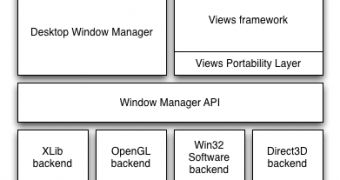With a six-week release cycle, it doesn't look like Google Chrome ever gets any huge new features. Small, frequent updates are nice, but they don't make a huge impression. However, this doesn't mean that the Chrome team is not working on bigger, long term features. One particularly interesting one is an UI revamp, from the ground up.
The team now wants to completely rewrite the UI and windowing infrastructure to make it possible to implement more advanced effects and features.
For example, the proposed new architecture will be hardware accelerated enabling all sorts of snazzy UI effects. Another benefit is that it will make the UI more platform independent, enabling developers to write code once for all supported operating systems including Chrome OS.
"As we expand the reach of Chrome onto a variety of different devices, the need for an improved windowing system is growing... As the desire to run Chrome on larger format devices grows, the need to display more than one window at a time is rising," an entry on the main Chromium website aimed at developers reads.
This is one of the reasons for the rewrite, the need for better windowing support in Chrome OS. Currently, since Chrome OS is aimed at netbooks, it only displays one window at a time.
Eventually, the team wants the browser to be able to have multiple windows displayed in Chrome OS, for larger devices.
Chrome OS also relies on a purpose built, simple window manager. The new architecture would eliminate the need for a window manager in Chrome OS enabling the UI elements to tap directly into OpenGL, the 3D graphics framework.
The Chrome team will build a window manager directly into Chrome, which will look and act the same on any platform.
The UI and other elements that need to be displayed will access an unified Window Manager API rather than the OS specific APIs, meaning that this code will only have to be written once.
The Window Manager API will then access whatever backend the OS provides, Direct3D or the standard Win32 libraries if there is no hardware acceleration on Windows, XLib and OpenGL on Linux and so on.
"There is also a desire to consolidate Chrome UI implementation between Chrome on Windows and Chrome OS, to expand the developer and testing community available for Chrome OS to the broadest possible group," Google explained.
"To be able to build the type of effects the UX team is designing for, we will want a windowing system capable of using hardware accelerated compositing and visual effects," it added.
For now, the Chrome team only has an overview of the planned feature, so there will be some months before the new hardware accelerated windowing system will make its way into actual Chrome and Chromium builds.

 14 DAY TRIAL //
14 DAY TRIAL //